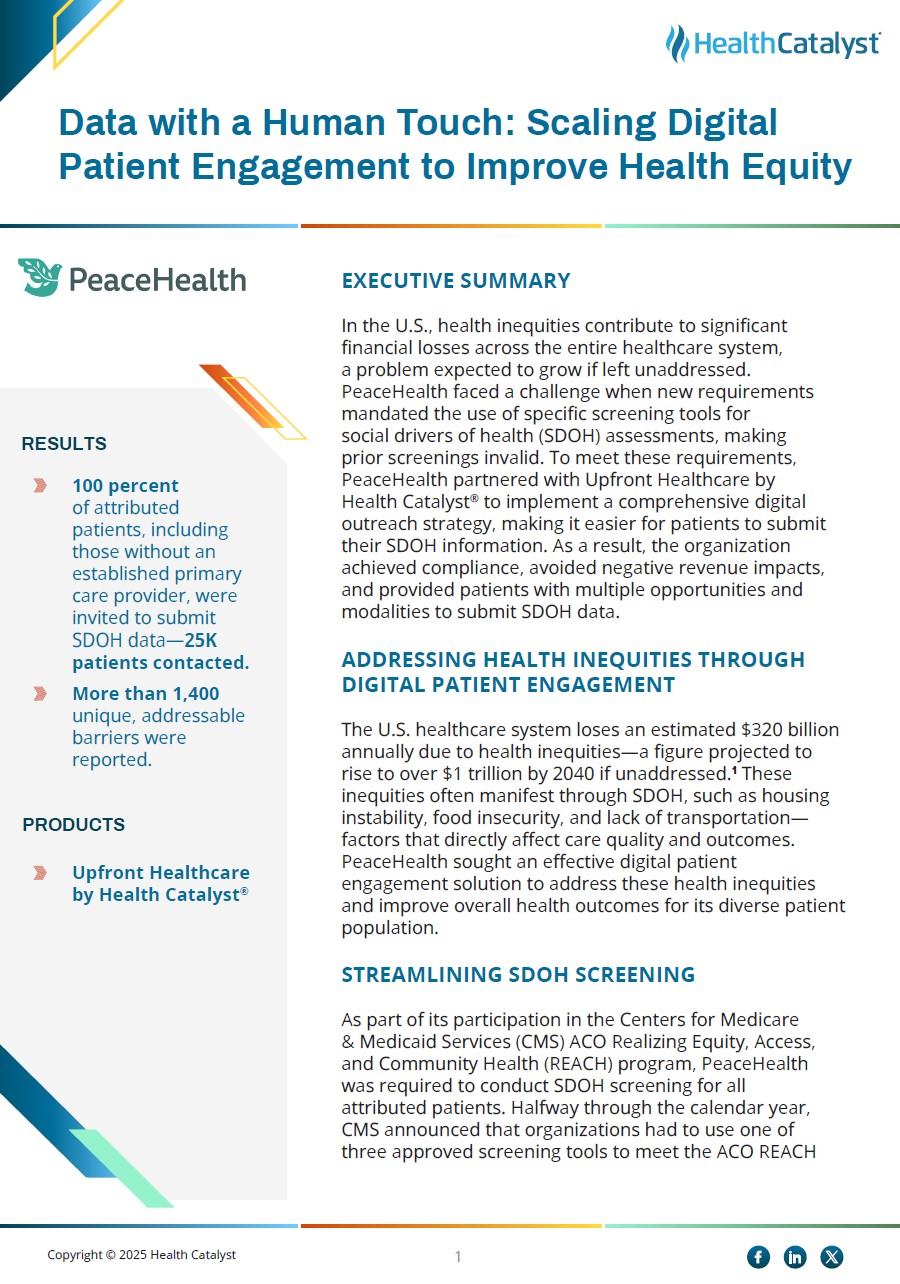In the U.S., health inequities contribute to significant financial losses across the entire healthcare system, a problem expected to grow if left unaddressed. PeaceHealth faced a challenge when new requirements mandated the use of specific screening tools for social drivers of health (SDOH) assessments, making prior screenings invalid. To meet these requirements, PeaceHealth partnered with Upfront Healthcare by Health Catalyst® to implement a comprehensive digital outreach strategy, making it easier for patients to submit their SDOH information. As a result, the organization achieved compliance, avoided negative revenue impacts, and provided patients with multiple opportunities and modalities to submit SDOH data.
The U.S. healthcare system loses an estimated $320 billion annually due to health inequities—a figure projected to rise to over $1 trillion by 2040 if unaddressed.1 These inequities often manifest through SDOH, such as housing instability, food insecurity, and lack of transportation—factors that directly affect care quality and outcomes. PeaceHealth sought an effective digital patient engagement solution to address these health inequities and improve overall health outcomes for its diverse patient population.
As part of its participation in the Centers for Medicare & Medicaid Services (CMS) ACO Realizing Equity, Access, and Community Health (REACH) program, PeaceHealth was required to conduct SDOH screening for all attributed patients. Halfway through the calendar year, CMS announced that organizations had to use one of three approved screening tools to meet the ACO REACH screening requirements. This shift rendered previous screenings invalid, necessitating the completion of new screenings. The organization needed to screen approximately 25K patients—an ambitious and necessary goal to enhance patient care and ensure compliance.
Traditional manual methods, such as phone calls, were ruled out because they would require over 2,700 labor hours. PeaceHealth’s internal EHR capabilities were unable to support the rapid development of a compliant electronic tool, leaving the organization in need of a scalable, efficient, and patient-friendly solution.
To address these challenges, PeaceHealth partnered with Upfront Healthcare by Health Catalyst® to develop and execute a comprehensive digital outreach strategy. PeaceHealth reviewed the three approved questionnaires and selected the Accountable Health Communities Health-Related Social Needs Screening Tool as its preferred screening tool. Upfront built the screening tool electronically as a questionnaire.
PeaceHealth developed a patient-facing webpage to provide resources for each of the screening domains, ensuring patients had immediate access to relevant information. The organization engaged a patient advocate to review the materials, ensuring they were easy to understand and complete from the patient’s perspective.
Using CMS patient eligibility criteria, PeaceHealth built an EHR report to generate a clean, structured patient roster. This enabled seamless data transfer to Upfront for outreach purposes. Upfront analyzed patient demographics, communication preferences, and accessibility factors to tailor patient outreach methods, ensuring maximum engagement and enabling PeaceHealth to deliver personalized outreach to each patient that resonated with their unique needs, executing a multi-channel engagement strategy, including:
Upfront indexed all outreach results from each methodology, enabling PeaceHealth clinics to track patient responses, initiate referrals, and follow up on identified needs.
PeaceHealth successfully navigated an urgent, large-scale screening requirement by leveraging innovative technology and a strategic partnership with Upfront. The organization met the ACO REACH program requirements and provided patients with multiple opportunities and modalities to submit SDOH data over eight weeks. Results include:
More importantly, the organization gained valuable insights regarding patients’ addressable barriers. The most prevalent barriers were insecurities related to housing, food, and transportation, enabling the organization to enhance patient services. Examples include offering in-home primary care services to those with transportation barriers, providing food boxes, and sharing information about community food resources to those with food insecurity.
“This initiative wasn’t just about checking a box for CMS. Using Upfront Healthcare to engage our patients enabled us to meet our patients where they are—digitally, emotionally, and socially—identifying barriers and adapting our service delivery to better meet patient needs.”
- Lauren Hamidian, MSN, RN, CCM, System Director of Ambulatory Care Management, PeaceHealth
Building on this success, PeaceHealth plans to leverage Upfront for the next round of SDOH screenings and optimize its strategies to engage more patients successfully. The organization will also apply its learnings regarding the various modalities for which patients best respond to other patient engagement opportunities.
1. Deloitte. (n.d.). The economic cost of health disparities. Deloitte Insights. Retrieved from https://www2.deloitte.com/us/en/insights/industry/health-care/economic-cost-of-health-disparities.html


